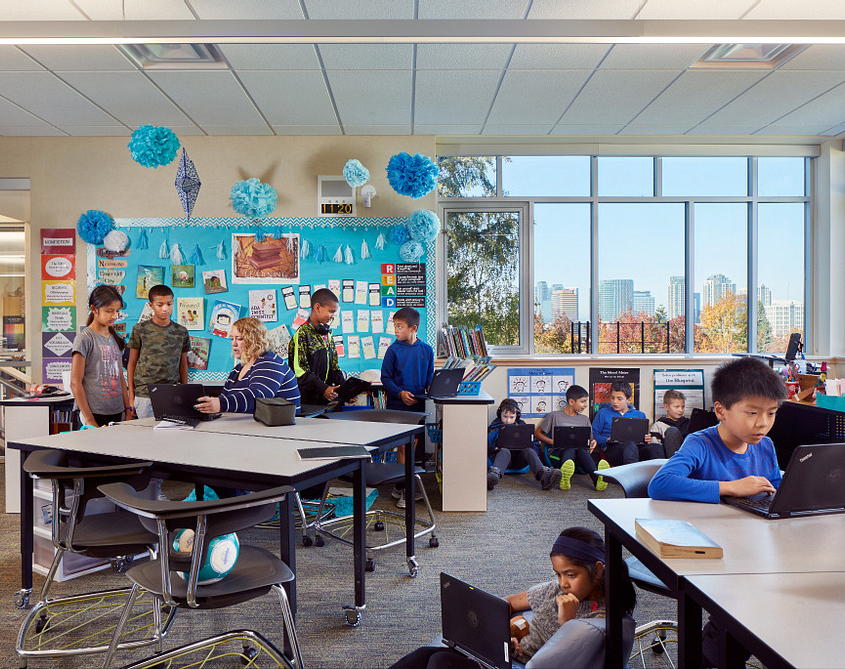K.I. – Can We Predict Education Trends in 2021?
For years, we’ve been asked what the classroom of the future will look like. We believe that by tapping into lived experiences, we can make more informed predictions. So, we’ve spent the last several months speaking with educators, students and design professionals. Below, we synthesize what we’ve learned through these conversations and consider how the student experience and the physical learning environment may evolve in the coming year.
Users: Prioritizing the Student
1. Personalized instruction: School systems have been accelerating the transition to personalized instruction. But the abrupt shift to remote learning necessitated by the pandemic slowed this transition.
Technology and artificial intelligence that tailor lessons to students’ unique needs could put us back on the path toward truly personalized learning. If widely accessible, such tools could help equalize opportunity within and across schools.
2. Personalized schedules: Through our student interview series, we learned that some students prefer a hybrid schedule. Most enjoy the freedom that remote learning affords them to plan their day as they see fit.
Hybrid models may continue beyond the pandemic. College students have long had much more control over when and how they engage in learning. Younger kids may soon have a bit more freedom to do the same.
3. Personalized projects: Students and teachers are embracing project-based learning, an instructional approach that encourages students to tackle real-world problems as a means of acquiring knowledge and mastering skills. When teachers assign personalized projects — say, by allowing history students to write songs instead of traditional reports — they encourage students to bring their passions into the classroom.
Environment: Making the Most of Every Space
4. Say goodbye to single-use spaces: For years, each room in a school served a single purpose: the math room was for arithmetic, the history classroom for learning about the past and the cafeteria for eating lunch. The only space to cross these boundaries was the “multipurpose room.”
But whether due to playful learning or social distancing requirements, we’re on our way to considering all spaces, indoors and outdoors, multipurpose spaces.
5. The great outdoors: Endless studies show that spending time outside is good for our health. We’ve learned to eat outdoors during the pandemic. It’s likely that we’ll do more learning outdoors, too — even in colder climates.
6. Let them play: Play is fundamental to humans. Yet, we really only integrate it into the curriculum for students in second grade or below.
We hope to see an increase in playful learning spaces because they tend to focus on what matters most — the student.
Experience: Virtual Learning Inspiring Long-Term Change
7. Where we live matters: Remote learning has given parents a front row seat to their children’s education. They’re much more engaged in their kids’ schooling, whether they like it or not.
That engagement may continue once kids return to in-person learning full time. Pre-pandemic, only about 10 percent of residents in certain districts voted in their local school board elections. Perhaps we’ll see a surge of interest in serving on the school board or the PTA. I, for one, am currently running for my children’s school board based on our school’s response to the pandemic.
8. The importance of mentors: Our “molders” — those who have the biggest influence on us during our formative years — tend to be teachers and coaches. The shift to virtual learning has limited access to these mentors. (In some cases, as I know all too well, they’re being replaced by TikTok stars.)
This year, we’ll see a desire for the return of in-person relationships as opposed to the virtual ones with which we’ve had to make do.
9. Active learning: Research shows that kids learn best when they can move around and collaborate with peers and teachers. Instruction via Zoom doesn’t exactly lend itself to movement. With smart design, educators can facilitate active learning remotely — perhaps by encouraging students to collect and use items around the home, for instance.
Learning from the Past
In 2020, we learned that it’s tough to make predictions about the future. But the pandemic has also equipped us with insights and experiences about education that will allow us to start designing a better future for our students.






